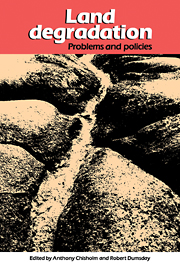Book contents
- Frontmatter
- Foreword
- Contents
- The Contributors
- Figures
- Tables
- Glossary
- Preface
- Land degradation and government
- I Physical and biological aspects of land degradation
- II Social costs
- III Legal, institutional and sociological factors
- IV Behavioural causes, economic issues and policy instruments
- V Pressure groups, public agencies and policy formulation
- 13 Pressure groups and policy formulation
- 14 Policy agents: their interaction and effectiveness
- VI Towards more effective policies for controlling land degradation: an overview
- A Rational approaches to environmental issues by Anthony Chisholm
- B Comments by Bruce Davidson
- C Comments by John Thomas
- D Participants at workshop on land degradation and public policy
- Bibliography
- Index
14 - Policy agents: their interaction and effectiveness
Published online by Cambridge University Press: 05 February 2012
- Frontmatter
- Foreword
- Contents
- The Contributors
- Figures
- Tables
- Glossary
- Preface
- Land degradation and government
- I Physical and biological aspects of land degradation
- II Social costs
- III Legal, institutional and sociological factors
- IV Behavioural causes, economic issues and policy instruments
- V Pressure groups, public agencies and policy formulation
- 13 Pressure groups and policy formulation
- 14 Policy agents: their interaction and effectiveness
- VI Towards more effective policies for controlling land degradation: an overview
- A Rational approaches to environmental issues by Anthony Chisholm
- B Comments by Bruce Davidson
- C Comments by John Thomas
- D Participants at workshop on land degradation and public policy
- Bibliography
- Index
Summary
Historical development of our administrative structure
The early settlers, in their efforts to supply food for the new colony, developed land use practices by trial and error, using European agricultural practices which proved to be totally unsuitable for the Australian conditions.
Initially the settlers had considered the Australian bush to be a harsh, cruel environment incapable of sustaining adequate production and they therefore set out to clear and ‘develop’ the land as quickly as they could. Even in the early stages of the colony, it was not long before this development brought problems to the environment. As early as 1803, Governor King proclaimed that the removal of trees from the river banks in the Sydney region was prohibited.
By the late 1890s the combination of inappropriate land use management, the spread of the rabbit, and a severe drought had seriously degraded large tracts of the arid and semi-arid regions, to the extent that many landholders were forced off the land. The subsequent Royal Commission of Inquiry into the condition of Crown Tenants in the Western Division of New South Wales, completed in 1901, was perhaps the first real attempt to deal with land degradation in Australia. The Western Lands Commission of New South Wales was formed shortly afterwards as a direct response to the Royal Commission's findings.
The Constitution of the Commonwealth of Australia came into being in 1901 and the responsibility for management of the land and its resources was effectively retained within individual states.
Information
- Type
- Chapter
- Information
- Land DegradationProblems and Policies, pp. 275 - 302Publisher: Cambridge University PressPrint publication year: 1988
